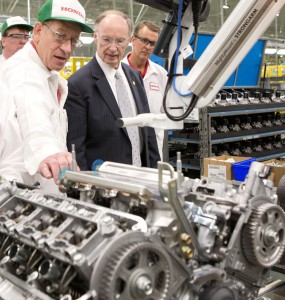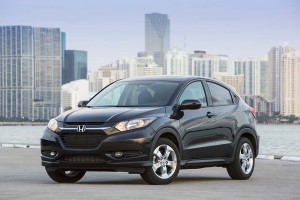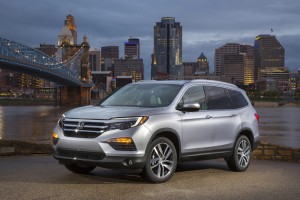Things will be getting busy at the Honda Manufacturing of Alabama plant today – make that busier – as the first of the maker’s new 2016 Pilot SUVs begins rolling down the line.
It’s the third-generation version of the three-row ute that has become not just one of the most popular vehicles in its segment but a symbol of some major changes at the Japanese brand. Long focused on sedans and coupes like the Accord and Civic, Honda is steadily shifting emphasis from passenger cars to sport- and crossover-utility vehicles.
Already, truck models make up 49% of total U.S. production, noted John Mendel, Honda’s top U.S. executive, “and we could flex that even further,” he said during a teleconference with reporters marking the launch of Pilot production. “That depends on the car market and how much the truck market grows.”
If anything, it seems almost certain that the truck side will top 50% in the near future. The Alabama plant is a critical part of that shift. It will have capacity to produce at least 120,000 Pilots annually, once the ramp-up of the new model is completed. The Lincoln, Alabama, factory also rolls out Honda Odyssey minivans and MDX utes for the upscale Acura brand.

Honda pumped $72 million into its Lincoln, Alabama, plant to build engines. The plant is adding three new products in the next year.
And, in less than a year, it will resume production of the midsize Ridgeline pickup, albeit an all-new version of the truck.
(Click Here for a review of the 2016 Honda Pilot.)
Last year, the sprawling factory produced 363,419 vehicles, all told, but Mendel said, “We have some upside potential as we bring new vehicles and new capacity online.”
To get there, Honda invested $508 million in the Alabama plant over the last three years, including $72 million for an engine plant now assembling 1,500 V-6s daily.
Like key Japanese rivals Toyota and Nissan, Honda now produces in North America the majority of vehicles it sells in the U.S. market. A new Mexican plant is responsible for the latest addition to the Honda truck portfolio, the B-segment crossover the HR-V.
(Click Here for a review of the 2016 Honda HR-V.)
The subcompact model enters a segment that barely existed until recently. In fact, Mendel chuckled as he recalled the skeptical response the concept version of the HR-V got when it was unveiled two years ago. But it joins a flood of new small crossovers such as the Jeep Rendezvous and Chevrolet Trax. And, as TheDetroitBureau.com reported this week, Hyundai expects to add a competitor in the B-segment, as well.
The 2016 Honda HR-V has gotten generally positive reviews that should give it a solid push as it reaches U.S. showrooms, according to industry observers. The biggest uncertainty for Honda is how American buyers will respond to the next-generation Ridgeline.

The compact crossover is quickly becoming one of the world's fastest-growing market segment and with the HR-V Honda is hoping to make a splash.
The original model also scored well with reviewers, at least initially, due to its unusual design. But the pickup quickly lost momentum and was temporarily dropped from the Honda line-up. The next Ridgeline will go back to a more traditional design – and will reach showrooms just as the moribund midsize segment shows some new signs of life after years of decline thanks to the launch of two offerings from General Motors.
Honda is by no means the only automaker shifting emphasis from traditional passenger cars to trucks. And there is a race to find new niches, such as the B-segment crossover. Mendel said the Japanese maker will continue to seek out new opportunities, though, “as you search for more white space there’s less (of it available).” And Honda won’t launch new products just to get an incremental 5,000 units of sales, he added.
(Hyundai planning small crossover and production version of Santa Cruz pickup. Click Here for the story.)
But American consumers “have opened up” to new alternatives, Mendel said, and Honda wants to make sure it doesn’t leave opportunities on the table for its competitors to exploit.


The U.S. market is the land of excess and this includes SUVs and trucks. In other countries most people are smart enough to understand that SUVs and trucks are not the optimal form of personal transportation for most people. In the U.S. the land of excess… people measure their self worth by how large the vehicle is that they drive or the house that they live in. It’s a strange mentality IMO.